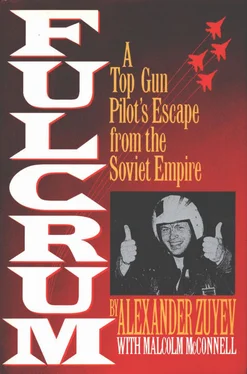At the upper right-hand corner of the main instrument panel, I deliberately pointed my finger to verify that the master arm switch was definitely off. But I did switch the weapons control system modes switch to radar, thus completing the linkage of the entire Alamo missile circuit.
Another setting for that switch was shlem, “helmet,” which I would not be using today, but Shatravka would. This was the helmet-mounted sight (HMS), a Soviet innovation that used a pair of infrared sensors mounted on the pilot’s helmet to track and lock onto targets for the Archer missile. You could achieve this lock-on simply by turning your head, not the entire aircraft. Intelligence officers had briefed us that the Americans had either been unable to perfect such a system or considered it superfluous. This was nonsense. There were many occasions in a close-in dogfight where the IRST sensor mounted in the clear Plexiglas dome forward of the canopy lost lock-on while the pilot could still see his target above or below. The helmet-mounted sight gave the Soviet pilot an extra set of sensors that could save his life one day. And the HMS was easy to use because the weapons computer linked the helmet sensor data directly to the swiveling IR seekers in the Archer missile nose.
In a close-in dogfight we had learned to fly with the missile trigger on the control stick depressed. If either the HMS or main IRST sensor in the nose dome locked on a fast-closing target, the computer would automatically fire the missile. These computer-aided sensors were much faster than human reactions. So there was no danger of missing a shot on an enemy slashing past your nose at supersonic speed because your reactions were too slow to pull the trigger. The beauty of the helmet sight was that you could kill the enemy, even if you did not have time to swing the nose of your plane to bear on him. The system was a quantum improvement over the traditional IRST sights I had trained with on the old MiG-23.
Having prepared the radar-homing and infrared missiles, it was time to set up the gun. After adjusting the cannon rate-of-fire control and gunsight for the thirty-five-foot wingspan of the opponents’ MiG-29, I squeezed the gun trigger to verify the system on the HUD. A funnel-shaped column of broken white lines appeared, wide end highest, with the small “11” symbol above it. The afternoon sun glare was bad, bleaching out the data on the clear panel of the HUD, so I pulled up the thick, smoked-glass sunshield plate to shade it. Now the electronic compass rose, indicating 27, due west, and the altitude and airspeed data showed in crisp computer-white digits. I was exactly at 13,500 feet and my airspeed was pegged on 350 knots. The large “27” in the lower right center of the HUD indicated I had two armed Alamo radar-homing missiles.
My final stop on the instrument panel was in the right corner, the SPO-15 radar-warning receiver. When I activated the receiver’s control panel on the right front cockpit console, the rings of green, yellow, and red threat lights surrounding the stylized aircraft symbol on the display flashed like the lights on a New Year’s tree and the beeping warning tone sounded in the cockpit. The SPO-15 was now active. Any opponent’s radar, or missile-guidance radar on the ground, sweeping my aircraft would appear on the display and a warning beep would sound in my earphones. The instrument was quite sensitive and would give me the bearing, relative power, and type of radar that was scanning me. If more than one enemy radar was active, the receiver would display the most dangerous threat by priority.
I had completed my cockpit air-combat setup just as we crossed the marshy coastline. I was now thirty miles from Ruslan and switched radio channels from 7 to 6.
“Brigadier,” I called my GCI controller “Three five zero with 351 on channel 6.”
My call sign for this three-month period was 350, and Nikolai’s was 351. Actually our official five-digit call sign was prefixed with 48, but few Soviet military pilots used all five numbers.
“Ponyal,” Vitaly’s crisp professional voice replied. “Roger, 350, altitude 13,500 feet.”
Now we popped up to 15,000 feet to intersect the oval air-combat range fifteen miles offshore. I banked left and headed south toward the far end of the circuit where Nikolai and I would hold orbit in the combat air patrol (CAP) sector just north of the Turkish frontier buffer zone. At this speed we covered the twenty miles in less than two minutes. Just as my distance measuring equipment and radio compass indicated I was in the CAP zone, Vitaly’s voice sounded again in my headset.
“Three five zero, you are in the holding zone.”
“Ponyal.”
I was never much of a talker on the tactical radio net. Some fellows, especially zampolits, were real chatterboxes. They were so nervous in the cockpit and so uncertain about controlling these powerful airplanes that they called out every bank and turn, every new heading and altitude change, as if they were air-control cadets in a classroom simulator, not Soviet combat pilots. The radio range of the electromagnetic spectrum might be invisible to human eyes, but certainly wasn’t to modern electronic scanners. Overly talkative pilots tended to forget that NATO ferret satellites and even the American AWACS radar planes could track you by your voice transmission. This might have been my last fight, but I still intended to maintain my own high professional standards.
I turned again onto a westward heading and checked my mirrors to make sure Nikolai was tucked up nice and close. There he was, in perfect position, less than 150 feet from my right wingtip. We both had on our navigation strobe lights at 100 percent power. This was a little trick we used to distinguish our flight from the “enemy” on a training sortie. One of the weakest points in Soviet training was that we did not often fly against different types of aircraft representing Western fighters, as did our American counterparts.
For a moment I stared at his plane, absorbing the rakish beauty of the powerful fighter. They say that function dictates form in both natural and human design. And just as Nature had evolved the predatory shark with smooth, hydrodynamic curves, the designers at the Mikoyan-Guryevich OKB had produced an aerial predator with a long, sharp nose, knife-edge wings, and the powerfully tapered fins of its vertical and horizontal tail surfaces. I loved this airplane and it would be hard to leave it behind and find another life.
But my decision to leave the Air Force was final. As much as I loved flying, I could no longer serve the Soviet government and the system where everything was based on lies, deceit, and personal and institutional corruption.
“Three five zero,” Vitaly called.
He wanted an indication of the tactics I planned for the air-combat engagement so the ground controllers could be certain there was no gross violation of safety standards. His request meant that Shatravka and his wingman had already crossed the coast and turned north for their own holding zone, about forty miles from ours. The safety regulations called for our flight to maneuver at odd-number altitudes — 3,000, 9,000, or 15,000 feet — while Shatravka’s flight used the even numbers.
“Plan Number Four.”
“Roger.”
I was about to begin my last dogfight as a Soviet fighter pilot.
On this leg of the holding orbit, I was flying parallel to the Turkish coast. The narrow band of green, backed by winter-brown foothills below snowy summit ridges, was the frontier of imperialist NATO, the sworn enemy of the Socialist Motherland. But to me, those mountains represented freedom. This CAP zone was only twenty-five miles from the frontier. It would have been so easy to tell Nikolai to take the lead because I had “problems with my radar.” Then, as he pulled ahead, I could have chopped my throttles, slid off on my left wing, and dove for the sea. Once below the GCI radar horizon, I could have applied full military power and dashed into Turkish airspace undetected. Certainly Vitaly in the GCI bunker would not have been unduly alarmed. He knew my dogfight Plan Four called for me and my wingman to separate, with Nikolai staying high while I dropped below Vitaly’s rival battle-control officer’s radar sweep.
Читать дальше










